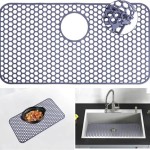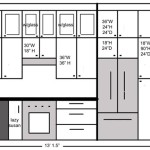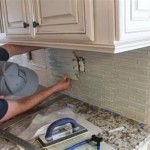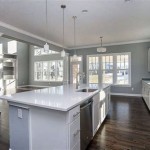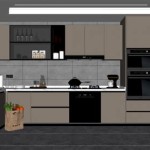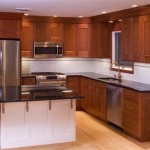Illuminating Vaulted Ceiling Kitchens: A Comprehensive Guide to Lighting Design
Vaulted ceilings, with their dramatic angles and expansive height, introduce unique challenges and opportunities when it comes to kitchen lighting. Unlike kitchens with standard 8-foot ceilings, those featuring vaulted designs require careful consideration of fixture placement, light output, and overall aesthetic to achieve both functionality and visual appeal. A poorly lit vaulted ceiling kitchen can appear dark, unwelcoming, and even smaller than its actual dimensions. Conversely, a well-designed lighting scheme can accentuate the architectural features, create a warm and inviting atmosphere, and provide ample illumination for cooking and other tasks.
Successfully illuminating a vaulted ceiling kitchen hinges on understanding the specific characteristics of the space. Factors such as ceiling height, angle of the slope, the presence of architectural details like beams, and the color palette of the kitchen all contribute to the overall lighting strategy. A balanced approach, incorporating multiple layers of light, is typically required to address the varying needs of a kitchen, from general ambient illumination to task-specific lighting for countertops and work areas.
Addressing the Challenges of Height and Angle
The primary challenge in lighting a vaulted ceiling kitchen lies in overcoming the increased distance between the light source and the work surface. Standard recessed lighting, often used in kitchens with traditional ceilings, may prove ineffective in this context due to the light spreading out over a larger area, resulting in insufficient illumination at countertop level. Similarly, pendant lights, while visually appealing, might not provide adequate general lighting if they are not strategically positioned and sized appropriately.
The angle of the vaulted ceiling also presents a unique set of considerations. Light fixtures installed on angled surfaces need to be properly aimed to direct light where it's needed most. This may involve using adjustable fixtures that can be tilted or rotated to focus the beam. In some cases, specialized fixtures designed specifically for sloped ceilings may be necessary to ensure proper light distribution and avoid glare. The reflection of light off the ceiling surface is also a factor to consider. Darker ceiling colors will absorb more light, requiring more powerful fixtures, while lighter colors will reflect light more effectively, potentially reducing the need for high-wattage bulbs.
Furthermore, accessibility for maintenance, such as bulb replacement, becomes a significant factor with high vaulted ceilings. Choosing long-lasting LED bulbs can minimize the frequency of maintenance. Thoughtful planning regarding access points, such as ladders or scaffolding, should be considered during the design phase to ensure ease of maintenance in the long term. In some cases, professional lighting technicians might be required for bulb changes, adding to the overall cost of ownership. Therefore, it is essential to select fixtures that allow for relatively easy bulb replacement, even at a height.
Integrating Multiple Layers of Light
A comprehensive kitchen lighting plan typically involves layering three distinct types of light: ambient, task, and accent. Ambient lighting provides the overall general illumination for the space, creating a base level of brightness. Task lighting focuses on specific work areas, such as countertops, sinks, and cooktops, providing the necessary illumination for food preparation and other tasks. Accent lighting highlights architectural features, artwork, or decorative elements, adding visual interest and creating a more inviting atmosphere.
In a vaulted ceiling kitchen, ambient lighting can be achieved through a combination of recessed lighting, strategically placed track lighting, or even pendant lights hung at varying heights. Recessed lighting should be spaced appropriately to ensure even distribution of light throughout the kitchen. Track lighting offers flexibility in aiming light towards specific areas, allowing for adjustments as needed. Pendant lights can add a decorative element while also contributing to the overall ambient light level. The choice of fixture will depend on the design aesthetic of the kitchen and the desired level of illumination.
Task lighting is crucial for safety and efficiency in the kitchen. Under-cabinet lighting is essential for illuminating countertops, eliminating shadows and providing ample light for food preparation. Pendant lights or track lights can be positioned above islands or peninsulas to provide task lighting for these areas. Over the sink, a dedicated fixture or a strategically placed recessed light can ensure adequate illumination. The type of bulbs used for task lighting should be chosen carefully to provide accurate color rendering, allowing for easy differentiation between ingredients and ensuring food is cooked properly.
Accent lighting can be used to highlight the unique features of a vaulted ceiling kitchen. Uplighting, directed towards the ceiling, can accentuate the height and angle of the vault, creating a sense of grandeur. Spotlights can be used to highlight artwork or architectural details such as beams or exposed brick. Dimmable accent lighting can also be used to create a more intimate atmosphere for dining or entertaining. The placement and intensity of accent lighting should be carefully considered to avoid glare or distracting hotspots.
Fixture Selection and Placement Strategies
Choosing the right light fixtures for a vaulted ceiling kitchen is paramount to achieving the desired aesthetic and functionality. A variety of options are available, each with its own advantages and disadvantages. Recessed lighting, as mentioned previously, can provide general ambient lighting, but may require more powerful fixtures or closer spacing to compensate for the height of the ceiling. Track lighting offers flexibility and adjustability, allowing for precise aiming of light towards specific areas. Pendant lights can add a decorative element and provide task lighting for islands or peninsulas. Chandeliers, while often associated with more formal spaces, can also be appropriate for vaulted ceiling kitchens, adding a touch of elegance and providing ample illumination.
The placement of light fixtures should be carefully planned to maximize their effectiveness. Recessed lights should be spaced evenly across the ceiling to provide consistent ambient lighting. Track lighting should be positioned to highlight specific features or provide task lighting for work areas. Pendant lights should be hung at a height that is both visually appealing and functional, avoiding blocking views or creating obstructions. The distance between the light fixture and the work surface should be considered to ensure adequate illumination without causing glare. The use of a lighting design professional can be beneficial in determining the optimal placement of fixtures to achieve the desired results.
Furthermore, the selection of light bulbs plays a crucial role in the overall lighting scheme. LED bulbs are generally recommended for their energy efficiency, long lifespan, and dimming capabilities. The color temperature of the bulbs should also be considered to create the desired ambiance. Warmer color temperatures (2700K-3000K) create a cozy and inviting atmosphere, while cooler color temperatures (3500K-4000K) provide a brighter, more energizing light. The color rendering index (CRI) of the bulbs should also be high to ensure accurate color representation. Bulbs with a CRI of 80 or higher are generally recommended for kitchens.
In summary, the process of illuminating a vaulted ceiling kitchen requires careful planning and attention to detail. By understanding the challenges posed by the height and angle of the ceiling, integrating multiple layers of light, and selecting appropriate fixtures and bulb types, homeowners can create a kitchen that is both functional and visually appealing. Consulting with a lighting design professional can be a valuable investment, ensuring that the final result meets the specific needs and preferences of the homeowner.

Best Feature Lighting Ideas For Vaulted Ceilings Loomlight

14 Of The Best Kitchen Vaulted Ceiling Lighting Ideas Lightopia

Kitchen Lighting For Vaulted Ceilings 1stoplighting

42 Kitchens With Vaulted Ceilings Kitchen Layout Floor Plans Ceiling

What S The Best Lighting For Vaulted Ceilings Amanda Katherine

Vaulted Ceiling Lighting Ideas

What S The Best Lighting For Vaulted Ceilings Amanda Katherine

Vaulted Ceiling Lighting Ideas

Transforming Your Kitchen With Vaulted Ceilings Cabinet Iq

Light Gray Kitchen Island Under Vaulted Ceiling Skylights Transitional

